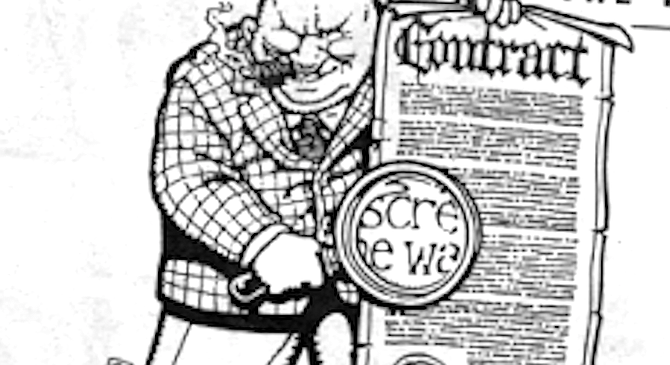 Facebook
Facebook
 X
X
 Instagram
Instagram
 TikTok
TikTok
 Youtube
Youtube

Dear Matthew Alice: Is there a legal minimum that the fine print in documents, etc., must be? — Mimi Labrucherie, USD
Mr. Master of Great Wisdom & Knowledge: You’re always told to read the “fine print” on any contract before signing it, right? Well, if it’s called ‘ fine print, ” how come I can’t read it unless I use a telescope? — A Guy, San Diego
Well, there’s your problem, Guy. Try a microscope. Mimi’s answer’s not so simple. Broadly speaking, where there is a legal mandate that a document, label, warning notice, etc. be legible, the standard is simply that the information be “clear and conspicuous,” wording taken directly from the Federal Trade Commission’s 1975 Magnusson-Moss Warranty Act. An FTC spokesman says some provisions of the Truth in Lending Act and some industrial trade regulations are more specific. As a general guideline, the FTC considers 8-point type the minimum legible. (For comparison, I’m told that M.A. is brought to you each week at 7.5 or 8 points, and most newspapers’ classified ads are 6 point.) But C&C is also a function of typestyle, ink and paper colors, line length, spacing between lines, and other factors which aren’t addressed. And while the FTC has jurisdiction in interstate commerce, most banking and credit-related documents, etc., the FDA is responsible for overseeing the laughable fly specks they call “labeling” on medications, the Treasury Department polices booze bottles, and the states themselves oversee another whole set of consumer information. C&C has many guardians. And how about those lines of bitty type that wing past you on the TV screen (“mice type,” the ad guys call it), most notably in car lease commercials. The info is required by law and is subject to the C&C standards. The FTC recommends that 5 seconds out of each 30-second commercial be devoted to full consumer warnings if the commercial contains one of a list of “trigger” terms (e.g., “monthly payments”). In five seconds, the average person can read 20 words. Ever see a car lease agreement that summed it all up in 20 words? Lawsuits have helped clarify exactly what constitutes “clear and conspicuous” for certain specific products/documents/etc., but you’d have to track those case by case. All in all, C&C is a mice-type nightmare.


Dear Matthew Alice: Is there a legal minimum that the fine print in documents, etc., must be? — Mimi Labrucherie, USD
Mr. Master of Great Wisdom & Knowledge: You’re always told to read the “fine print” on any contract before signing it, right? Well, if it’s called ‘ fine print, ” how come I can’t read it unless I use a telescope? — A Guy, San Diego
Well, there’s your problem, Guy. Try a microscope. Mimi’s answer’s not so simple. Broadly speaking, where there is a legal mandate that a document, label, warning notice, etc. be legible, the standard is simply that the information be “clear and conspicuous,” wording taken directly from the Federal Trade Commission’s 1975 Magnusson-Moss Warranty Act. An FTC spokesman says some provisions of the Truth in Lending Act and some industrial trade regulations are more specific. As a general guideline, the FTC considers 8-point type the minimum legible. (For comparison, I’m told that M.A. is brought to you each week at 7.5 or 8 points, and most newspapers’ classified ads are 6 point.) But C&C is also a function of typestyle, ink and paper colors, line length, spacing between lines, and other factors which aren’t addressed. And while the FTC has jurisdiction in interstate commerce, most banking and credit-related documents, etc., the FDA is responsible for overseeing the laughable fly specks they call “labeling” on medications, the Treasury Department polices booze bottles, and the states themselves oversee another whole set of consumer information. C&C has many guardians. And how about those lines of bitty type that wing past you on the TV screen (“mice type,” the ad guys call it), most notably in car lease commercials. The info is required by law and is subject to the C&C standards. The FTC recommends that 5 seconds out of each 30-second commercial be devoted to full consumer warnings if the commercial contains one of a list of “trigger” terms (e.g., “monthly payments”). In five seconds, the average person can read 20 words. Ever see a car lease agreement that summed it all up in 20 words? Lawsuits have helped clarify exactly what constitutes “clear and conspicuous” for certain specific products/documents/etc., but you’d have to track those case by case. All in all, C&C is a mice-type nightmare.
Comments